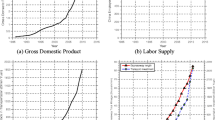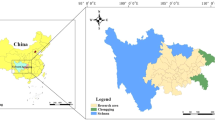Abstract
How does the development of one transport mode influence the development of another? This paper uses time-series data to test whether inter-model network externalities influenced the development of road, canal, and port infrastructure in England from 1760 to 1830. The main finding is that road development had a positive effect on canal development. The results suggest that the option value of waiting to invest in a canal diminished when nearby road improvements were initiated because there was less uncertainty about future profits from canal tolls. They also suggest a reinterpretation of road transport in the Industrial Revolution and point to the general importance of inter-modal network externalities.

Similar content being viewed by others
Notes
The role of economic and financial development in promoting transport networks is stressed throughout the literature. See Banister and Berechman (2000) for a recent summary.
For an overview of improvements in ports see Jackson (1983).
See the Journals of the House of Commons entry for 8.12.1743 in Great Britain, Parliament, House of Commons (1803).
Ibid. 23.2.1743.
For example, Duckham (1983 p. 103–04) questions the negative correlation between interest rates and canal acts.
The titles come from a database in the Parliamentary archives. See HL/PO/PU/1/1790/30G3n118.
Ibid. HL/PO/PU/1/1769/9G3n9.
Ibid. HL/PO/PU/1/1787/27G3n32.
Ibid. HL/PO/PB/1/1824/5G4n221.
The North included Cumberland, Northumberland, Westmoreland, York, Lancaster, and Chester. The West Midlands included Shropshire, Staffordshire, Derbyshire, Nottinghamshire, Leicester, Northampton, Buckinghamshire, Bedfordshire, Hertfordshire, Warwick, Worcester, Hereford, Oxford, and Monmouth. The east Midlands include Lincolnshire, Norfold, Suffolk, Cambridgeshire, and Huntingdon. The southeast includes Essex, Kent, Middlesex, Surrey, and Sussex. The Southwest includes Hampshire, Berkshire, Gloucestershire, Wiltshire, Dorsetshire, Somersetshire, Devonshire, and Cornwall.
The net present value of investing in year zero is \( - 800 + 50 + 0.5 \times \left( {\sum\limits_{t = 1}^\infty {{{150} \mathord{\left/ {\vphantom {{150} {\left( {1.1} \right)^t }}} \right. \kern-\nulldelimiterspace} {\left( {1.1} \right)^t }}} } \right) + 0.5 \times \left( {\sum\limits_{t = 1}^\infty {{{50} \mathord{\left/ {\vphantom {{50} {\left( {1.1} \right)^t }}} \right. \kern-\nulldelimiterspace} {\left( {1.1} \right)^t }}} } \right) = - 750 + 750 + 250 = 250\).
The net present value of waiting until year 1 is \(0.5 \times \left[ {{{ - 800} \mathord{\left/ {\vphantom {{ - 800} {\left( {1.1} \right)}}} \right. \kern-\nulldelimiterspace} {\left( {1.1} \right)}} + \sum\limits_{t = 1}^\infty {{{150} \mathord{\left/ {\vphantom {{150} {\left( {1.1} \right)^t }}} \right. \kern-\nulldelimiterspace} {\left( {1.1} \right)^t }}} } \right] = 386\).
Road, canal, and port promoters may have also delayed their projects until they knew whether manufacturing production increased or interest rates declined. I have omitted discussion of these factors, but they are incorporated in the empirical analysis.
Assume that all projects take one year to complete. The NPV of initiating in year 0 is still below the NPV of waiting until year one when it is known whether nearby road and port acts have been passed. In year 1, the NPV of investing is higher than the NPV of waiting to invest in year two since \( - 800 + \sum\limits_{t = 1}^\infty {{{150} \mathord{\left/ {\vphantom {{150} {\left( {1.1} \right)}}} \right. \kern-\nulldelimiterspace} {\left( {1.1} \right)}}^t } > {{ - 800} \mathord{\left/ {\vphantom {{ - 800} {\left( {1.1} \right)}}} \right. \kern-\nulldelimiterspace} {\left( {1.1} \right)}} + \sum\limits_{t = 2}^\infty {{{150} \mathord{\left/ {\vphantom {{150} {\left( {1.1} \right)^t }}} \right. \kern-\nulldelimiterspace} {\left( {1.1} \right)^t }}} \).
Jim Shead (2007) provides detailed information on canal construction times. See ‘History by Waterway.’ For more details on the length of road improvements see Pawson (1977). Details on port construction times are scattered throughout the literature. The River Humber organization reports that the port improvements in Hull were begun 1775 and completed in 1778. See http://website.lineone.net/~ktaylor297/index12.htm.
In this case, there is a possibility that the canal promoter will initiate in year zero if there is sufficiently high probability that road or harbor projects will be initiated. Suppose q is the probability that road or harbor projects are initiated in year one, then the NPV of initiating in year zero is \( - 800 + q \times \sum\limits_{t = 2}^\infty {{{150} \mathord{\left/ {\vphantom {{150} {\left( {1.1} \right)^t }}} \right. \kern-\nulldelimiterspace} {\left( {1.1} \right)^t }}} + \left( {1 - q} \right) \times \sum\limits_{t = 2}^\infty {{{50} \mathord{\left/ {\vphantom {{50} {\left( {1.1} \right)^t }}} \right. \kern-\nulldelimiterspace} {\left( {1.1} \right)^t }}} \). The NPV of waiting to decide until year 1 is \(q \times \left[ {{{ - 800} \mathord{\left/ {\vphantom {{ - 800} {\left( {1.1} \right)}}} \right. \kern-\nulldelimiterspace} {\left( {1.1} \right)}} + \sum\limits_{t = 3}^\infty {{{150} \mathord{\left/ {\vphantom {{150} {\left( {1.1} \right)^t }}} \right. \kern-\nulldelimiterspace} {\left( {1.1} \right)^t }}} } \right]\). Manipulation of these two expressions shows that the NPV of initiating in year zero is higher if q > 0.88.
Suppose the road or port promoter knows in year one that the canal will be completed in year 3. The NPV of initiating in year one when the road/port project takes 1 year and canal projects take 2 years is \( - 800 + {{50} \mathord{\left/ {\vphantom {{50} {1.1}}} \right. \kern-\nulldelimiterspace} {1.1}} + \sum\limits_{t = 3}^\infty {{{150} \mathord{\left/ {\vphantom {{150} {\left( {1.1} \right)^t }}} \right. \kern-\nulldelimiterspace} {\left( {1.1} \right)^t }}} = 609\). The NPV of waiting to initiate the road/port improvement in year 2 is \({{ - 800} \mathord{\left/ {\vphantom {{ - 800} {\left( {1.1} \right)}}} \right. \kern-\nulldelimiterspace} {\left( {1.1} \right)}} + \sum\limits_{t = 2}^\infty {{{150} \mathord{\left/ {\vphantom {{150} {\left( {1.1} \right)^t }}} \right. \kern-\nulldelimiterspace} {\left( {1.1} \right)^t }}} = 636\).
Let I be the investment costs. Using the same parameters as in footnote 16, the NPV of investing in year 0 is –I + 1050. The NPV of waiting until year 1 is \(0.5 \times \left( {{{ - I} \mathord{\left/ {\vphantom {{ - I} {1.1}}} \right. \kern-\nulldelimiterspace} {1.1}}} \right) + 750\). Manipulating these expressions shows that the NPV of waiting until year 1 is greater than the NPV of investing in year 0 only if the investment cost exceeds 550.
There could be a short-term feedback from improvements to industrial production via aggregate demand effects but these are likely to be small and should not dramatically affect the estimates. There might also be a correlation between industrial production in t − k and the error term in some future year like t + j. In models where variables are sequentially exogenous, the bias is usually lower if T is large (Wooldridge 2002, p. 302), which is the case here with T = 69.
For example, future research could address measurement error and omitted variables problems with two-stage least squares (see Wooldridge 2002). However, it is difficult to find an instrumental variable that is correlated with road acts in t − 1, but uncorrelated with the error term for canal acts in t. Political variables, like years when there were elections or new prime ministers could potentially work, but it is not clear why they would affect road acts but not canal acts.
References
Albert W (1972) The turnpike road system in England, 1663–1840. Cambridge University Press, Cambridge
Armstrong J, Bagwell P (1983) Coastal shipping. In: Aldcroft D, Freeman M (eds) Transport in the Industrial Revolution. Manchester University Press, Manchester
Ashton TS (1968) The Industrial Revolution, 1760–1830. Oxford University Press, Oxford
Banister D, Berechman J (2000) Transport investment and economic development. UCL Press, London
Barro RJ, Sala-I-Martin X (1992) Public finance in models of economic growth. Rev Econ Stud 59:645–661
Bogart D (2007) Neighbors, networks, and the development of transport systems: explaining the diffusion of turnpike trusts in eighteenth-century England. J Urban Econ 61:238–262
Bogart D, Richardson G (2006) Parliament, property rights, and public goods in England from 1600–1815. Working Paper
Chalklin C (1998) English counties and public building, 1650–1830. Hambledon, London
Clark G (2001) Farm wages and living standards in the Industrial Revolution: England, 1670–1869. Econ Hist Rev 3:477–505
Crafts N, Harley CK (1992) Output growth and the British Industrial Revolution: a restatement of the Crafts–Harley view. Econ Hist Rev 45:703–730
Duckham BF (1983) Canals and river navigations. In: Aldcroft D, Freeman M (eds) Transport in the Industrial Revolution. Manchester University Press, Manchester
Evans EJ (2001) The forging of the modern state: early industrial Britain 1783 1870. Longman, London
Global Financial Data (2007) United Kingdom 2 1/2% Consol Yield. Available via http://www.globalfinancialdata.com/index.php3?action=detailedinfo&id=1301
Great Britain. Parliament. House of Commons (1803) Journals of the House of Commons. HM Stationary, London
Hadfield C (1968) The canal age. Praeger, New York
Holmes G, Szechi D (1993) The age of oligarchy: Pre-Industrial Britain 1722–1783. Longman, London
Innes J (1998) The local acts of a national parliament: parliament’s role in sanctioning local action in eighteenth-century Britain. In: Dean D, Jones C (eds) Parliament and locality, 1660–1939. Edinburgh University Press, London
Jackson G (1983) The ports. In: Aldcroft D, Freeman M (eds) Transport in the Industrial Revolution. Manchester University Press, Manchester
Levinson D (2002) Financing transportation networks. Edward Elgar, Cheltenham
Parliamentary Archives (2007) Portcullis. Available via http://www.portcullis.parliament.uk/DserveA/
Pawson E (1977) Transport and economy: the turnpike roads of eighteenth century Britain. Academic Press, New York
Pindyck R (1991) Irreversibility, uncertainty, and investment. J Econ Lit 29:1110–1148
Shead J (2007) History by waterway. Available via http://www.jimshead.com/waterways
Ward JR (1974) The finance of canal building in eighteenth century England. Oxford University Press, Oxford
Wooldridge J (2002) Econometric analysis of cross section and panel data. M.I.T. Press, Cambridge MA
Author information
Authors and Affiliations
Corresponding author
Additional information
I would like to thank David Levinson and Gary Richardson for providing helpful comments on earlier drafts. I would also like to thank Patricia Suzuki for providing valuable research assistance.
Rights and permissions
About this article
Cite this article
Bogart, D. Inter-Modal Network Externalities and Transport Development: Evidence from Roads, Canals, and Ports During the English Industrial Revolution. Netw Spat Econ 9, 309–338 (2009). https://doi.org/10.1007/s11067-008-9060-0
Received:
Accepted:
Published:
Issue Date:
DOI: https://doi.org/10.1007/s11067-008-9060-0




